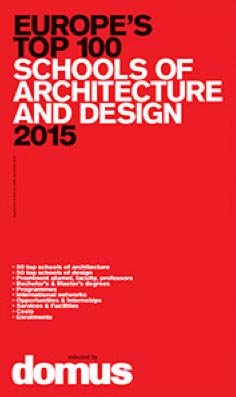We were the only Architecture School in Scotland to be listed in Domus Magazine's ‘Europe’s Top 100 Schools of Architecture and Design 2015’.
We were delighted to have been selected for the third year running by their editorial team as worthy of inclusion in the top 50 architectural institutions offering the 'most suitable and coherent curricula' to train contemporary architects.
The selection criteria included institutions that have a recognised reputation in the community of architects and designers, international relations with other institutions and the evaluation of professional results obtained by degree holders. Location, facilities, prominent professors, alumni success and the international exchange opportunities on offer were all evaluated. The supplement was issued with the December 2014 Issue of Domus n. 986. Domus recognises that our architecture students are encouraged to spend study periods abroad testing the professional waters, establishing business relationships and engaging in participatory processes. We are proud that we continue to be recognised as 'one of the most politically, socially and culturally engaged schools in Europe'.
‘Domus’ was created by Gio Ponti, Italian designer and architect. It remains a recognized and influential voice in the fields of international architecture, design, and art. Produced in Italy, it is widely read and distributed since it was first published in 1928, ‘Domus’ is bilingual.

Criteria
The criteria Domus uses to select their top 50 schools of architecture were summarised as:
1. The creation of a network of accredited references in the field of training in architecture and design that represents homogeneous geographic areas. This group allows us to validate the selection; it reflects differences between the schools and highlights aspects of excellence, new or old.
2. The examination of the widest possible geographic range in Europe.
3. The selection of institutions (especially for architecture) that have a recognised reputation in the community of architects and designers. This value clearly tends to privilege schools with a long tradition over new ones. On the other hand, although it is continuously being updated, European education is based on consolidated knowledge and institutions where the heritage of knowledge in many cases is not easily perceived by the bibliometric or digital parameters used in the more scientific disciplines.
4. In the design field, we considered belonging to a network of authoritative associations (e.g. Cumulus) in the field of education to be an accrediting factor.
5. The relationship with and use of new technology and equipment.
6. International relations with other institutions and internship systems for professional training.
7. The evaluation of professional results obtained by degree-holders after a certain lapse of time, taking into consideration the specificities of the different European institutions. Young designers and new graduates were interviewed on their formative experience.
Archdaily.com reported on Issue Two which is now free to download. We are featured on page 18.
The schools are not ranked - this guide is centred around the idea that design schools have become too diverse to compare with one another, believing instead that for every potential student there is a school that is the right match. Each school is accompanied by its vital statistics, such as the length and cost of the course, the size of the school itself and its influential tutors and alumni, as well as a well-researched description of its educational priorities and culture.